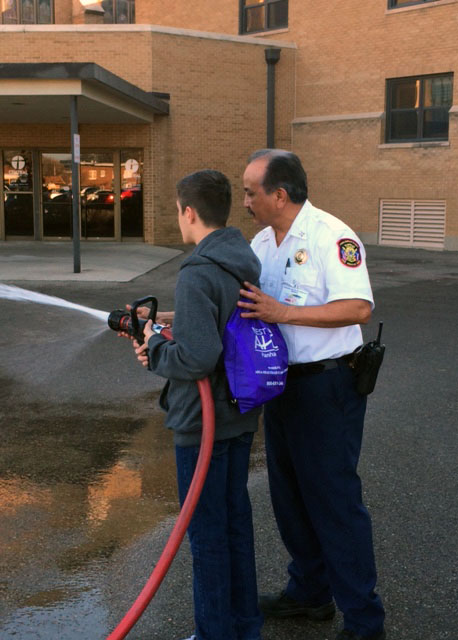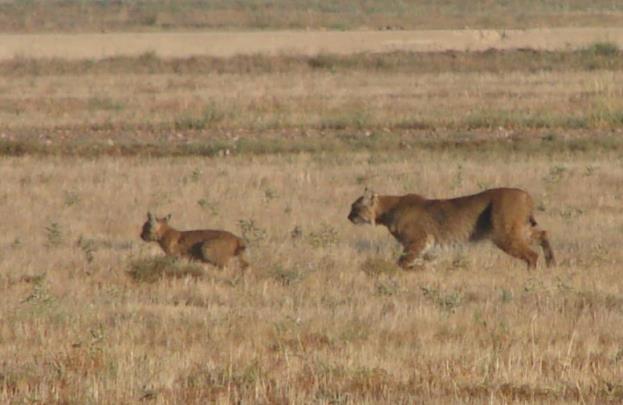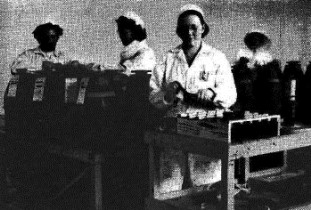Pantex Blog
Pantex Participates in Career Conference
Consolidated Nuclear Security, LLC is committed to encouraging the next generation of technical professionals, skilled trade workers and first responders.
Engineers, sheet metal workers and firefighter paramedics from the Pantex Plant shared the education and skill requirements for their jobs at a recent Step Up to Success conference.
Area middle school students attended two sessions of their choice with professionals from career fields such as healthcare, business, engineering, agriculture science, criminal justice, law, communications, information technology, culinary arts and skilled trades.
“I’ve been representing Pantex at this event for about 12 years,” said Joe David Villarreal, Pantex Fire Department captain and shift officer. “My favorite part is seeing the students get excited when they can actually put their hands on the equipment and try it.

Joe David Villarreal, Pantex Fire Department captain and shift officer, helps a student test a fire hose at the Step Up to Success career conference. About 600 middle school students attended the conference to learn the education and skill requirements for a variety of career fields.
This year, Villarreal and Alvino Alvarez Jr., Pantex Fire Department firefighter and motor pump operator, brought a grass rig used for fighting brush and grass fires and allowed students to test a fire hose. They also handed out fire prevention and smoke detector literature.
Los Barrios de Amarillo, a civic organization established by Hispanic community leaders, hosted the conference for more than 600 middle school students in the Texas Panhandle. Los Barrios also offers a high school conference in the fall.
Women's History Month - Part 3
Since the days of World War II, women have played an important part in accomplishing the Pantex mission. While their loved ones fought on the battlefield front lines, they did their part on the Pantex assembly line.
Women dubbed the “80s Ladies” worked the Pantex assembly/disassembly line during the Cold War.
Today, hundreds of women engineers, scientists, technicians and professionals, including the first female Pantex site manager, help ensure the safety, security and effectiveness of the nation’s nuclear weapons stockpile.
In honor of Women’s History Month, we will look back at four historical articles about women at Pantex. Part three of the series is an excerpt from the April 1943 Pantexan.
WOW Fashions
Matching lipstick and nail polish was a must for the glamour girl prior to Pearl Harbor. But, only a few months later, the most glamorous girls in the country were chucking those same hands into cotton work gloves, hiding their Joan Crawford lips behind weird looking masks, and exchanging their smart costumes for the uniform of the WOW.
 Women are in the war with both feet and to do their production front jobs efficiently, without accident or injury, they must dress safely and work safely. Keeping these precautions constantly in the minds of women workers is one of the big jobs of safety engineers in war plants throughout the country. And, Pantex is no exception.
Women are in the war with both feet and to do their production front jobs efficiently, without accident or injury, they must dress safely and work safely. Keeping these precautions constantly in the minds of women workers is one of the big jobs of safety engineers in war plants throughout the country. And, Pantex is no exception.
As a matter of curiosity, safety engineers were asked to break down the safety records of men and women workers at Pantex on a comparative basis. The picture which resulted was so alarming that even a casual glance at it should be enough to startle the women out of their lethargy and keep them on the alert from now on.
From September 1, 1942 to April 1, 1943, women accounted for 15.56 percent of the total hours worked at Pantex. During the same period, 23.58 percent of all accidents and injuries befell this same group of female workers. (The figures quoted to not apply to the employees of the administration, employment and hospital buildings since their exposure to hazards is comparatively slight.)
It is easy to understand why the ratio of mishaps to women was high in the early days of the plant’s history. Most of them were housewives, school teachers, etc., and very few had experience as industrial workers.
But women are quick to catch on. During the month of February, they accounted for only 16.61 percent of all accidents and injuries despite the fact that their percentage of hours worked remained approximately the same, 15.11 percent of the total. They had to learn how to do their jobs safely and realizing the danger element in their work, they were careful to use the protective equipment provided them.
Wild Pantex – Wintertime Ramblings
Article by Jim Ray, Pantex Wildlife Biologist/Scientist
Amidst a busy schedule and the winter cold, there is plenty going on with our Wild Pantex.
Two female bobcats are parading half-grown kittens around the facility. The boldness and naïveté of the “teenaged” youngsters result in more sightings, which will taper off as the birth of the next litters draw near. Although hard to see, ear tags worn by the mothers reveal their age and lineage.
As I write, several of the ten Swainson’s hawks we have been tracking in South America are drifting this way through South and Central America. We are gathering data on their interactions with wind farms and, once they arrive on their nesting territories on and around Pantex, monitoring will expand to include how wind energy development may affect their productivity in nesting.
The first Purple Martins have already arrived at their colonies and we will soon be capturing birds and removing the tiny geolocator- and G.P.S.-data loggers as we notice them. The data will enable the large collaboration we are involved in to look closer at roost sites along the migration routes and in wintering areas. This is in an attempt to figure out why this songbird is experiencing a decline in its range wide population.
Pantex made a big splash Feb. 19-21 at the annual Texas Chapter of The Wildlife Society meeting in Corpus Christi, Texas. More than 700 government, non-governmental, university, private and student wildlife biologists attended the meeting. Four presentations on Pantex-sponsored work were given:
- Laurie Groen, Texas Tech University graduate student, presented Modeling Wind Turbine Collision Risk for Migrating Swainson’s Hawks at an International Scale.
- Lena Thurmond, a recent West Texas A&M Masters graduate, presented Habitat Selection of Bobcats in a Texas High Plains Ecosystem.
- Becki Perkins, Texas Tech University doctoral student, presented Transmitter Influences on Raptor Agility and Prey Capture.
- I presented Migratory Connectivity of Texas and Continent-Wide Purple Martin Populations.
This winter has also been a time of writing annual reports and working with collaborators on a couple of manuscripts. I’ll save mention of those until they are published, but we are excited about their upcoming releases. Overall it has been a great start to a new year!

A very healthy female Pantex bobcat and her half-grown kitten. Notice her eartag.
Women's History Month - Part 2
Since the days of World War II, women have played an important part in accomplishing the Pantex mission. While their loved ones fought on the battlefield front lines, they did their part on the Pantex assembly line.
Women dubbed the “80s Ladies” worked the Pantex assembly/disassembly line during the Cold War.
Today, hundreds of women engineers, scientists, technicians and professionals, including the first female Pantex site manager, help ensure the safety, security and effectiveness of the nation’s nuclear weapons stockpile.
In honor of Women’s History Month, we will look back at four historical articles about women at Pantex. Part two of the series is from the December 1942 Pantexan.
Fear Turned to Enthusiasm as I Watched Women Load Bombs
By Lillian Corse
I WAS SCARED. When I was asked to come from the downtown employment office to get a story over in Zone 11, I accepted with alacrity. Then I started thinking and the more I thought the more goose pimples popped out on my arms – Zone 11 is a bomb loading line!
Upon arrival at the reservation, I was handed a pass and sent on my mission, accompanied by Bob Canning, Pantexan staff photographer.
Almost before I knew it I was being searched for matches at the line time office. Leaving my purse with a guard, we headed for the change house cafeteria. Bye the time I was fortified with some food I felt more at ease. Also the jovial mood of the employees who were eating helped. They seemed to be having fun.
Then came the real test. We were moving down the ramp closer and closer to actual operations. For six month, I had been signing people up as line workers. Always with the question of danger came up I had assured, women and men alike, that it was very pleasant work and definitely no more dangerous than crossing the street might be. It was all a matter of statistics anyway.
By the time Bob and I, accompanied by D.A. Murphy, superintendent of Zone 11, reached the guard at the receiving room, my feeling of tension had relaxed, but I still had a tendency to hold my breath, walk on tiptoe, and talk in a whisper. After the heels of my shoes were taped, I knew there was no turning back then. The die was cast. I think at first I felt as a parachute jumper must feel the first time he plunges headlong into space.
I had “jumped” and as we entered the big receiving, painting and inspection room my feeling was one of mingled awe and elation. Women, I had been told, were “manning” this line, and there they were – operating hoists, driving a little yale electric truck, in fact doing practically all the work.
They were enjoying their work, too. True, they were taking it seriously. They were people with a job to do and from all reports were doing it well. Here I lost all feeling of fear and became intensely interested.

There's nothing to it" say Juanita Fowler, Rosie Barnes and Naomi Middleton (left to right). But there is - plenty!
One of the safety signs I read seemed to typify to me the entire attitude. The sign read “foresight is a darn sight better than no sight.” These people were exercising care and foresight, but they were all at ease and obviously enjoying the work.
There were these women, most of whom I had talked with at some time – housewives, school teachers, cooks, sales girls – all doing their part toward the war effort by making bombs. To some it was possibly “just a job.” To most, however, it was a job to help win the war.
To Jewel Visage, an appealing girl who is a puddler, it’s a way to get back at the Japs.
“I love my job.” She explained, and her bright eyes glistened. “It sure makes you feel good to know that every day’s work helps avenge Pearl Harbor, Bataan and the rest. That’s especially true,” and her face took on an expression of determination, “when you have lost your only brother at Bataan.”
As I went through the line, I was impressed with the fact that so many people were cleaning – mopping, sweeping and washing. Everything was immaculate. This clean-up brigade is leaving little chance for stray bits of explosive dust to be about. They will be some of the real heroes of this war, mostly unsung but definitely appreciated. Even the white coveralls worn by the workers contribute to the appearance of cleanliness.
There is no smoking on the line. The only place employees are allowed to smoke is in the change house cafeteria and there they can’t use matches. Electric lighters are placed about on the walls.
Some of the few men in Zone 11 are the Ordnance inspectors, men who are working under civil service, inspecting the bomb cases when they come in and the finished bombs when they go out.
But back to the women, for this is really their story. They have convinced the men that they can load bombs and load them fast and well, and frankly, most of the men were very skeptical to begin with Mr. Murphy wasn’t for had seen women succeed at this job before. Vilas Bewby, shift B superintendent, was skeptical at first and admitted as much. When I talked with him he was most enthusiastic.
“Given a little more time and experience these women can produce as much and hold their own with any line using only men.” Mr. Newby said.
Mr. Price, an Ordnance inspector, admitted that he too had been very doubtful about using women, but he was ready to “take back” all he’s ever thought. In fact, everyone in authority I talked with was enthusiastic about the work the women were putting out. In the tail pour room, the girls were proud of the output for the day and to me, the uninitiated, it sounded good for us and bad for our enemies. Each day’s output could, well placed, put many strategic bases out of operation.
Ella Lee Singleton of Borger, a former sales girl, and Gertrude Ball, a housewife, also of Borger, were painting caps and liking it.
As I walked into one room, Ethel Carpenter of Lubbock, who had never been employed other than as a housewife, drawing hot TNT in to a container. She was as nonchalant as if she were watching dishes and yet no one sensed that she knew it was smart to talk all necessary precautions.
A sense of awe again overpowered me as I stood in the amatol pouring room and watch one man and five women filling a bomb with deadly amatol. There was so much potential power there than precautions reached a maximum, but again one is conscious of the fact that although these people know it’s smart to follow “all the rules,” they are not afraid.
I wasn’t afraid anymore either. I had great respect for the place, yes, but no fear. As I came to the end of the line, I had a great feeling of pride in these women. They are truly WOWS in more than one sense of the word. They are succeeding and they are turning out many pounds of destruction daily. As I walked contemplatively down the long ramp I thought, “the hand that rocks the cradle is the hand that rules the world.” And never, perhaps more so than now.
CNS addresses employees’ benefits concerns
More than 400 Consolidated Nuclear Security (CNS) employees at Pantex met with vendor representatives last week during on-site consultation sessions to address issues, questions and concerns they were experiencing with the administration of their health care benefits.
Michelle Reichert, Pantex Site Manager, viewed the consultations as a step in the right direction, “Over the past two months, many of our employees have experienced issues with the administration of their health care plans, specifically prescription drugs, medical and dental plans – this is not acceptable,” she said. “Bringing the vendor representatives to Pantex for on-site, 30-minute, one-on-one sessions gave employees a confidential setting to ask questions, address issues, get information and learn how to make their benefits work for them.”
Future health care benefits consultation sessions are also being scheduled at Y-12.
CNS is also improving its health care benefits communications and advocacy for employees. In addition, CNS is forming an internally-focused working group to review current plans and evaluate whether adjustments can be made to the plans while still meeting Department of Energy contract requirements and the future implications of the Affordable Care Act.
While changes in benefits were and remain necessary under the CNS contract, employees at Pantex and Y-12 provided feedback that the challenges faced when using their benefits were not acceptable. As a result, CNS has increased efforts to actively work with its providers and demanding more from them to address health care benefits issues.
